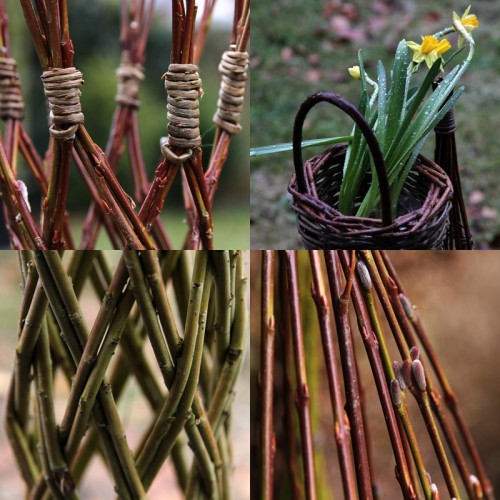This wekend we were working with willows in the wet garden.

I’ll just follow up on this post.
I have seen and admired willow weaving for many years. But I newer tried making anything myself, until we saw our good friend Sette and her beautiful handcrafted willow wickerwork, and she urged me to try it. I was a little proud then.
This weekend Sette came all the way from the other end of Denmark to teach a dosen or more of us in the art of willow weaving.
I think that everybody left with a good feeling inside. -Proud of themselves and the work they’d done.
Thank you very much Sette.
Here you can see the materials before the course started.

I like the collage very much, and appreciate the strong, deep colors. I think they’re just right for this time of year. Now I want to know if you were weaving and braiding living willow branches into a screen, or working with branches you’d cut? It makes a striking effect.
Wrestling my weakening memory wondering which word would cover the work: Weaving! Thanks Gerry.
You are right. 🙂 We use cut willow branches and they are living. This means that after the work is finished, we put them into water until they grov roots. Then they are planted and they will grow. Of course they need lots of water – as willows do.
I made my first ‘Belgian tree’ last summer. The buds are just beginning to show now. It’s ‘Belgian trees’ in the left images.
For the wickerwork in the basket you’d use dead willow branches soaked and softend in water.
I didn’t know they would still be living after your were done with them. I saw lots of willows being sold at the market last weekend. Just thought they were for decoration and didn’t know you created stuff from them. Very cool!
They could be cut last year – and dead. Or this year and alive. They are used for different purposes. I’m not an expert, but as I understand it, you use the dead willow branches for all the work that has to keep it’s shape after drying. You use the living branches for building live fences for example.
Det er nogle meget smukke billeder. De( træerne ) har du også gjort godt!
Mange tak Sette. Vi skylder dig æren for alle de flotte ting, der blev produceret.
Oh, I want to make a live fence! We have quantities of willow on the beach of Grand Traverse Bay. I wish that Sette could be here to teach a course, but I will have to make do. I’ll let you know how it goes.
What a beautiful mosaic to explain your willow working ! I did not know you could make live fences with these branches. Natural art, I love it. Thank you for this interesting and inspiring post.
I think the willows are really lovely – you’ve captured them really well in your photos.
Thanks for your comments Gerry, Isabelle and Tammy.
I’ll find a photo with some of our results. They are good, but not experts work. —Next year!!
…tak til Sette for en lærerig indførelse i ‘Pilenes kultur’
Og en tak til jer, Carsten & Lise for et fortrinligt lørdagsarrangement i jeres våde have !
Kærlige hilsner
fra Michael
Vi håber på jeres deltagelse i næste lektion.
Halløj Carsten
Er du begyndt til pileflet?
– hvor fint 🙂
Ja, nem’li ja Hanne.
Jeg må jo øve mig inden jeg går over til peddigrør!